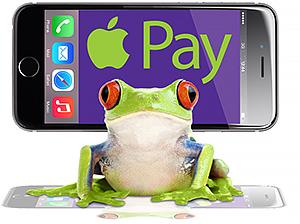November 2014: Is it safe to pay for something by sending your credit card information to a checkout terminal straight from your smartphone? No swiping, no signature, no anything tangible?
You bet! Advanced encryption and security technologies make Apple Pay more secure than physical credit cards for you and the companies you buy stuff from. Here’s why:
- It uses one-time encryption codes that work like two-factor authentication codes. The same encryption code, which is basically a string of random data, cannot be used for a second transaction. So stealing the code is worthless.
- Clerks never hold your credit card in their hand or know your name. Which means you won’t get the polite “Thank you for shopping with us, Mr. Frog,” as you leave the counter but that’s a miniscule price to pay.
- Retailers aren’t capturing or storing your information. So it can’t be stolen from their servers, making retailers happier, too — who the heck wants that kind of liability these days anyway? Not Target or Home Depot, that’s for sure.
- Apple isn’t capturing and storing your information. Your credit card number is encrypted and stored in the Secured Element chip on your Apple device and your device only. Apple doesn’t record or store your transaction data either. It’s stored on your device for 30 days and that’s it.
- If you lose your phone, you can lock it or wipe it. Try doing that with your wallet.
- Your fingerprint is needed to operate it. Apple Pay uses the built-in iOS fingerprint scanner to enable the transaction. Even the most disgruntled cashier (or the next person in line) would notice if someone was using a dismembered digit to operate an iPhone.
You can use Apple Pay to check out from within retailers’ apps, too, provided the store has added a “Pay With Apple Pay” option to its checkout process.
Apple Pay is available on iPhone 6, iPhone 6 Plus, Apple Watch and the new iPads. It currently works with the top three credit cards — Visa, MasterCard and American Express — six major banks and dozens of retailers. More cards, banks and stores are coming on board soon. Here’s CNET’s complete list that will be updated regularly.
What if you don’t have an iPhone 6 or other shiny new Apple devices?
Apple Pay may be getting all of the attention but it wasn’t first out of the gate. Google Wallet was. Google Wallet also uses Near Field Communication (NFC) and NFC chip technology but the system has never really taken off. Since plenty of smartphones have NFC chips, including Samsung and Nokia phones, all this Apple Pay attention might actually give Google Wallet the boost it needed.
Another app payment system in the works is called CurrentC. It’s being developed jointly by some of the biggest retailers out there — Walmart, Best Buy, 7-Eleven and others — and should launch next year. Meantime, some CurrentC retailers like CVS and Rite Aid are disabling the NFC readers at their stores to keep their customers from using (and loving) Apple Pay. Plus, one of the most important things CurrentC retailers want is the ability to track your purchases and behavior, something Apple Pay prevents.
Whether you end up going with Apple Pay, Google Wallet, CurrentC or whatever other system leaps onto the scene, one thing is for sure. Any of these choices are safer than the antiquated pieces of plastic with magnetic strips that are currently in your wallet.
| You may also be interested in: |

